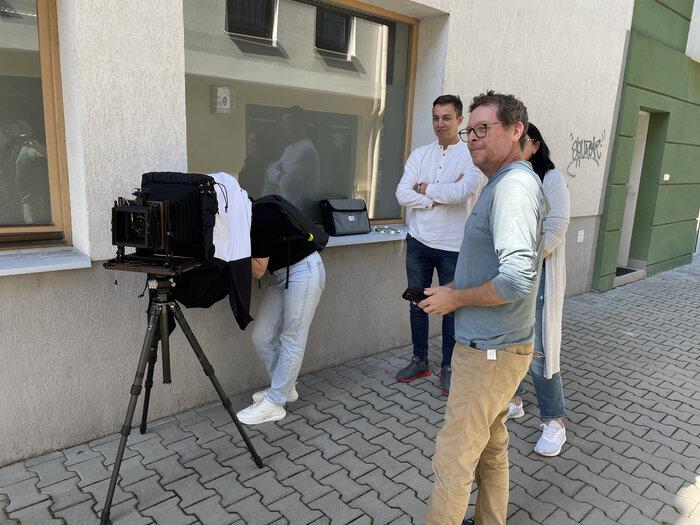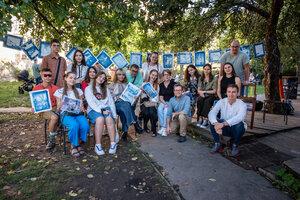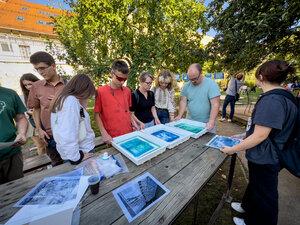
Andy Bale explaining and demonstrating how an 8x10 view camera works to Ukrainians living in Banska Bystrica, Slovakia
By Jolene Phan ‘24
"Most artists produce work to have some sort of exhibition somewhere," Andy Bale, Dickinson College art lecturer said. "It needs the community to survive." Over the past several years, Bale's collaborative photography projects across the globe have been made possible through the Center for Civic Learning & Action's Civic Engagement Fund. His projects uplift marginalized voices, foster cross-cultural understanding, and support civic learning along with college-community engagement that benefits the public good.
Bale's ongoing photography project in collaboration with Jon Cox, Associate Professor of Art and Design at the University of Delaware, "Arrivals: What's Left Behind, What Lies Ahead" documents the stories of refugees, immigrants, and displaced Indigenous peoples in the United States and abroad. It began in 2019 in Boise, Idaho, which has become a relocation destination for refugees from over 120 countries. "Boise looked a lot different than what I thought Boise, Idaho would look like" Bale said. "It is a melting pot from all over the globe that represents over 120 countries right now, with people now living in a wonderful place and adding their unique diverse cultures."
What started as a single project in Idaho has expanded into an international effort. Bale and his collaborators have since worked with the Roma community in Central Europe, Ukrainian refugees in Slovakia, Maasai in Kenya, and displaced populations worldwide. At each site, they facilitate PhotoVoice photography workshops for community members and record their stories.
Bale calls the PhotoVoice photography workshops "visual storytelling workshops." Participants learn photographic techniques and are encouraged to capture images reflecting on themes like community, home, and the future. For many, it is their first time operating a camera. They develop cyanotype prints from their photos to keep. "It's a way to connect with people and share my knowledge of photography with people that don't have that knowledge," Bale said.

Pop up exhibition of participants work created during one of Andy Bales' PhotoVoice workshop in Banska Bystrica, Slovakia

Ukrainian students studying in Banska Bystrica, learning the cyanotype process during one of Andy Bale PhotoVoice workshops
A key part of the project is spotlighting participants' voices. "We give them a prompt to think about when they go out and photograph," Bale explained. In Slovakia, Ukrainian refugees photographed places and things that made them feel at home in their new community. For Bale, "the why of why we do service trips is so big." He aims to foster cross-cultural understanding by uplifting participants' lived experiences.
This collaborative spirit aligns with Dickinson's Center for Civic Learning and Action and its mission of ethical civic leadership. Student trip leaders have joined Bale in the field, gaining hands-on experience with community engagement. "I try and incorporate a student in the field with me, and they don't have to be an art major," Bale said. "It's a way of connecting with the student on a very personal level." Students reflect that these experiences shape their worldviews and careers.
The Civic Engagement Fund has been crucial in supporting Bale's community-based work through grants for collaborative action projects, engaged pedagogy, and engaged scholarship. "I know the project is much larger than what I ever thought it was going to be, and I think it's much more important," Bale said. "The refugee and immigration crisis is only going to get exponentially worse." He aims to put a human face to these issues through storytelling.
Bale encourages other faculty interested in community-engaged work to apply for the Civic Engagement Fund. When thinking about a project, he suggests including a hands-on component so that there is something tangible at the end. He found this to be incredibly beneficial for the students and community members. Whether starting small with an existing course or proposing a large new initiative, the fund can support innovative, ethical projects that promote the public good in Carlisle and beyond. With an openness to letting conversations unfold, Bale has seen his work blossom in new directions through community relationships.
Most recently Bale returned from an international artist in residency program in Kenya, where he once again teamed up with his colleague Jon Cox. Here they worked with the local Maasai living on the Nashulai Conservancy with a focus on the Netii Apa (Netii Taata) Story-Tellers project. Bale and Cox, demonstrated and taught, community members the photographic process known as the cyanotype. Using this process community members could now preserve their ancestral knowledge of medicinal plants and pass that knowledge to the younger generations. He draws parallels between the displacement of Indigenous groups in the U.S. and the Maasai people. “The Maasai are much like our Native Americans, where the government has continually pushed them off their homelands,” Bale explained. By facilitating cultural exchange, he hopes to expand perspectives.
In May of 2024, Bale’s work will take him to Ireland to work with more Ukrainian refugees and other diaspora living in Ireland and again in September of 2024 to attend and present his work at the Climate on Culture Conference in Galway. Bale’s work is scheduled to be exhibited in the Slovakian Embassy in the U.S. in spring of 2024 and Bale is also in talks with colleagues at Emory University who hope to have the work exhibited there in late 2024 or early 2025.
At its heart, Bale's work is about relatability. "The problems are still the same," he said of the marginalized communities he works alongside globally. He strives to find shared humanity across differences. During workshops, he observes how "making something is to engage our mind and the physicality of making." The collaborative process of artmaking opens dialogue.
For more information about the Civic Engagement Fund and how you can apply, please visit the CCLA Civic Engagement Fund webpage.
For more information about the "Arrivals: What's Left Behind, What Lies Ahead," project please check the website.